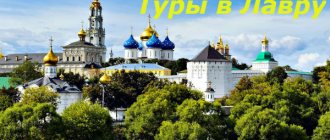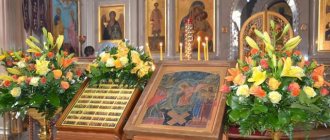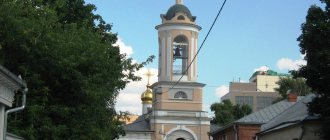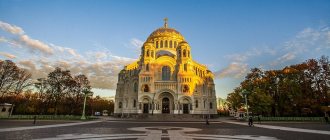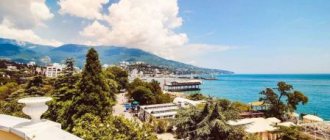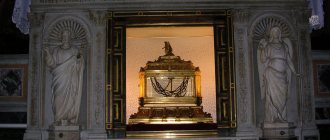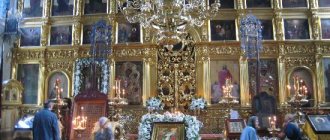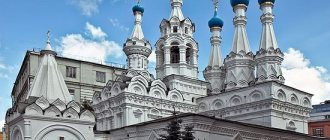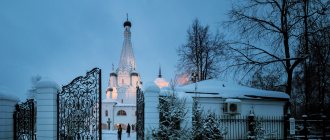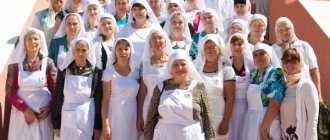After the baptism of Rus', the common people could not abandon pagan habits and beliefs for a long time. Orthodoxy is closely intertwined into a single tangle with the existence of goblin, brownies, etc.
Therefore, when lightning struck a modest church on Tagansky Hill, and not only did it strike, but struck the cross itself, the people flocked to the abode of God with great enthusiasm. By that time the temple already had a certain fame and was made entirely of stone.
By the way, this prevented the fire from developing, which saved all the surrounding buildings.
Holy Gates of the Temple of Nikita the Martyr. The old ones were destroyed in 1936. The new ones were built in 1996 and are equipped with chapels
There was a record of this event in the chronicles, which made it possible to approximately determine the date of construction of the temple of the Holy Martyr Nikita.
Years passed and the church gradually grew. Outbuildings were added, the masonry was updated, and the decoration of the temple became richer.
1992
this year, the Athonite courtyard was made from the Church of Nikita the Martyr
During the Soviet Union, the temple was almost destroyed.
They had already prepared plans and even dismantled outbuildings and a fence.
However, the church was defended by ordinary residents who came out to defend the building.
After the collapse of the USSR, the temple was transferred back to the Russian Orthodox Church, and in 1992 it was turned into the Athos courtyard in Moscow.
This is what the Church of Nikita the Martyr looked like in 1882 after the restoration by A. Popov
Athos courtyard in Moscow: it all began with the temple of Nikita the Martyr
The Church of Nikita the Martyr on Shvivaya Hill did not arise just like that. According to sources, it was built on the site of a much older building. The fact is that in the 15-16 centuries there was a settlement from pre-Moscow times on Tagansky Hill.
Much later, when Moscow expanded, the settlement merged with the capital city.
And during the time of Ivan the Terrible, all dangerous enterprises associated with the fire craft were transferred to the town. The result was a working town of blacksmiths, potters and boilermakers.
The very first mention of the temple dates back to 1476. Then the building was wooden. But according to the same chronicles, in 1533 the church was struck by lightning, but there was no fire.
1533
according to archaeologists, this year, after a lightning strike, the temple was made of stone
Archaeologists suggest that already at that time the temple was made of stone. This looks logical, the Tatar-Mongols lost the lion's share of influence on Rus', and the country no longer paid tribute to the Golden Horde.
Therefore, extra funds appeared, which were spent on the improvement of cities and temples.
In the history of the Church of the Great Martyr Nikita there is another date, which is written on the inset stone - 1595.
In addition, on the stone there is the name of the person who sponsored the construction of the church - Savva Vagin, a merchant.
This is how entrepreneurs engaged in trade were called in ancient Rus'. But there is evidence that the temple was not built from scratch.
In addition to the actual entries in the chronicle. In the basement of the church, in its most ancient place, masonry is made of “Aleviz” brick, which began to be used at the beginning of the 16th century.
Icon of the Great Martyr Nikita the Gothic
Nikita Gotha is an ancient Christian saint and great martyr.
Lived in the fourth century AD.
As is clear from the name, he was born in one of the Gothic tribes. These tribes lived in the north along the banks of the Danube and often raided the Roman Empire.
Nikita was baptized by Bishop Theophilus himself. After baptism, he began to preach Christianity among his fellow tribesmen and other related peoples. Participated in intertribal wars.
He suffered a terrible death from the pagans for preaching.
In honor of this saint, the most important part of the Athos courtyard was consecrated.
The Church of Nikita the Martyr on Shvivaya Hill was rebuilt
For a very long time, the church was only occasionally repaired: the masonry was renewed, the interior was cleaned, etc. The temple underwent more radical changes at the end of the seventeenth century.
Around 1684 - 1685 the temple building was expanded. There was a tented bell tower of its own.
The main innovation was the chapel dedicated to the Annunciation of the Blessed Virgin Mary. It was placed south of the main building. For the convenience of believers, the northern portal (entrance) was rebuilt. A new refectory has appeared.
The next time renovation of the temple began only in 1740.
To the existing chapel, another one was added, dedicated to the Venerable Onuphrius the Great and Peter of Athos. An interesting architectural solution was the construction of an open gallery.
People walking along it had a view of the Moscow River and the Kremlin. Unfortunately, in our time the view has changed somewhat and the panorama of ancient times is blocked by the “Stalin skyscraper”.
Nikitinsky Temple is located on the western part of Tagansky Hill. Previously, you could see the Moscow River and the Kremlin from here, now you can see one of the “Stalinist” skyscrapers
At the end of the nineteenth century, the Russian architect A. Popov carried out a complete restoration of the Athos courtyard
The famous Russian architect A. Popov put his hand to the temple. This happened at the end of the nineteenth century.
The architect was tasked with carrying out a thorough restoration of the temple complex. In addition, he was also involved in the design of the new chapel. This time dedicated to Equal-to-the-Apostles Princess Olga.
According to modern archaeologists, the Temple of St. Nikita the Martyr is a striking example of Old Russian architecture. It combines styles from different eras. The complex itself is included in the heritage list of the Russian Federation.
The Soviet authorities demolish the fence, but leave the temple.
After the abdication of Nicholas II and the Bolsheviks coming to power, most of the clergy were divided.
This had a detrimental effect not only on the fate of priests disloyal to the young Soviet government, but also on spiritual buildings. Churches and seminaries were closed by the dozens, and the premises were often used as warehouses, boiler houses, or simply demolished.
At first, the Church of Nikita the Martyr was not touched. Services continued to be held there and sacraments were performed.
Everything changed in 1936, when the government decided to demolish the temple and even began to implement this plan. The fence and outbuildings were the first to be damaged. But the church itself was not offended by local residents.
Contrary to modern slogans and “revelations,” the Soviet government listened to its citizens.
Moreover, in the mid-fifties, when Khrushchev’s atheistic ideological program began to be implemented, the temple was restored. All buildings have been renovated and partially preserved.
The work was supervised by the architect Lev Arturovich David. After the renovation was completed, part of the premises was given over to warehouses for the Diafilm studio. This continued until 1990.
After the revolution
In 1918, the Athonite Metochion in Moscow virtually ceased to exist. There was nothing unique in its fate; the same fate befell many other Orthodox churches and monasteries. Both in Moscow and throughout Russia. This expressed the atheistic policy of the Bolsheviks who came to power. Over the course of several decades, they methodically destroyed the foundations of Russian Orthodoxy, as well as other religious denominations. The buildings located on the territory of the metochion were given over for housing, and the rector, Hieromonk Macarius, was repressed in January 1919.
The Temple of Nikita the Martyr became a branch of the Greek Athos
In 1991, the Soviet Union falls apart into its component parts.
At this moment, the Russian Orthodox Church begins to receive back the property taken away by the Bolsheviks and more.
1991
this year the Church of the Great Martyr Nikita is given back to the Russian Orthodox Church
In the same year, the Church of the Great Martyr Nikita was given back to the Russian Orthodox Church. And the very next year the church changed its status to the “Compound of the Athos Monastery” in Moscow.
In fact, this is a church analogue of the embassy only from the Athos Panteleimon Monastery.
Currently, the metochion is preparing future monks for the above-mentioned monastery.
One of the Athos monasteries. Athos is translated from ancient Greek as “holy mountain”
Athos is a complex of monasteries in Greece, located in a remote location. It is believed that the most pious Christians live there.
It is difficult to get to the monasteries, there is no road, and supplies are carried in baskets. One of the main prohibitions on Athos is visiting monasteries for women. The rule also applies to female animals.
Until 1996, the temple did not have a gate or fence. They were demolished back in 1936. The gate, built in the mid-90s, is called the “Holy Gate”.
The name is not accidental; in their towers there are two chapels dedicated to the Great Martyr Panteleimon and the Monk Silouan of Athos.
Shrines of the New Athos Monastery
Today the courtyard of the New Athos Monastery has a simply magnificent view. Pilgrims and tourists come here to not only look at all the beauty, but also visit all six temples and pray in front of the holy images.
One of the most grandiose temples that are part of the community is Panteleimon's Cathedral. It is more than 50 meters long and 33 meters wide. It is crowned with five shining domes. Many experts note that the most famous icon painters and artists worked on the painting of the temple.
Icons
It should be noted that the icons of the New Athos monastery are very valuable for the Orthodox world. Among them, it is worth highlighting the miraculous icon of Our Lady of the Deliverer. On it, the Mother of God is depicted with the Child of God sitting on her left hand. The baby holds a scroll in his left hand.
The holy image was given to the monastery by the Greek elder Martian, who brought it from Athos itself. Before he died, the elder bequeathed the holy image to the monastery. They pray before the image in the following cases:
- about healing the disease,
- about getting rid of mental anguish,
- ask for help in times of trouble,
- from getting rid of bad habits.
The best article for you, go to: Joseph-Volotsky Monastery
In addition to the icon, the shrine of the monastery is a miraculous cross with a particle of the Tree of the Life-Giving Cross of the Lord and the relics of Simon the Zealot.
Metochion of the Athos Monastery: how to get there, address, official website and schedule of services
Information technologies have become an integral part of human life, and even the Church is forced to use them.
Thus, many churches and holy fathers have their own pages on social networks, and various charity sites help reach the priests for free. For example, before the Belarusian father Valerian.
Nikitinsky Temple has become a significant monument of ancient Russian architecture. The date of its foundation is 1595
How to get there? The exact address of the Moscow courtyard of the Athos Monastery is Moscow, st. Goncharnaya, 6
The Athos Compound also has its own official website. On the website you can find all the information available about the temple complex. But the main thing is that there is a schedule of services in the church.
It is worth noting that services are held at the Compound, as in Athos, everything happens at night. Services usually start at 22:00 and last until the morning.
By leaving a comment, you accept the user agreement
In every corner of the Orthodox world there are places that are revered as saints: for example, in Greece there is Holy Athos, in the Donbass there is the Svyatogorsk Lavra, in the Russian North there is the Valaam Monastery, in the Moscow region there is the Holy Trinity Lavra of St. Sergius and the Storozhevsky Monastery. There is such a place in Abkhazia - and I want to tell you about it today.
This place is interesting not only for its status quo, but also because it is located in a country where the majority of its inhabitants traditionally adhere to their own religion (even while classifying themselves as Orthodox or Muslims) - Abkhaz monotheism, that is, faith in one God (a unique example of primordial monotheism, the oldest religion of humanity - a relic that has survived to this day). And this place is called – New Athos Monastery .
New Athos Monastery (full name - Monastery of the Holy Apostle Simon the Canaanite on New Athos ) is located in the city of New Athos (25 kilometers west of the city of Sukhum), on the very shore of the Black Sea (at the foot of Mount Athos). This place is one of the most picturesque on the entire coast of the Caucasus, distinguished by luxurious vegetation and fabulous beauty. And among this lush subtropical herb, the majestic domes of the Orthodox monastery, overshadowed by crosses, can be seen from afar, seemingly accidentally lost.
The history of the monastery begins in the last quarter of the 19th century. In 1874, the Russian Athonite Panteleimon Monastery (on the Holy Mountain, in Greece) was under threat of closure (the leadership of the Holy Mountain, together with the Greek clergy, with the help of the Ottoman authorities, planned to take the entire brethren of the monastery to Asia Minor and leave there for the restoration of the empty Christian monastery).
When the abbot of St. Panteleimon’s monastery became aware of these plans, he urgently wrote a petition to the Russian ambassador in Constantinople, Count Ignatiev, in which he begged to petition the king for “the granting of a corner of land in the Black Sea region for the establishment of a monastery or monastery there, which would belong to Athos Panteleimon’s monastery.” monastery."
The place for the monastery, on behalf of the Athonite elders, was chosen by the resident of the Panteleimon Monastery, Hieromonk Arseny (Minin). The place was chosen on a mountain (which in its outline resembled Mount Athos), not far from the cave in which, according to legend, the Apostle Simon the Canaanite prayed and suffered martyrdom.
Satisfying the request of the monks and in the interests of Orthodox education of the local population, by order of Emperor Alexander II (November 27, 1875), land was allocated for the construction of the monastery in this corner of Abkhazia (although the issue of moving the St. Panteleimon Monastery from Athos was already removed from the agenda day). From this moment, in fact, the official history of the monastery begins.
Already in 1876, construction of the lower part of the monastery began on the deserted shore of the Black Sea, and the construction of the monastery itself was basically completed by 1896. Over the course of twenty years, a colossal amount of work was completed - to clear the site, part of the mountain was cut off and tens of thousands of tons of earth and rock were removed. The solution to this problem was further complicated by the fact that the site of the future monastery was located on a significant elevation and did not have convenient access roads, and most of the building materials were delivered by sea both from Russia and from abroad (for example, roofing tiles were made in France, in Marseille).
After all the work was completed, the monastery complex consisted of a network of temples (one of them - the temple in honor of the Intercession of the Most Holy Theotokos - was subsequently lost in the History of the monastery), the most majestic of which was the main cathedral - Panteleimonovsky. At its laying (in 1888), Emperor Alexander III and Empress Maria Feodorovna were present (a small bell was cast in their honor), who presented the monastery with musical chimes, which were later installed on the bell tower.
At the meeting place between the king and the abbot of the monastery, the monks subsequently built a chapel, and the path along which the king walked from the Temple of Simon the Canonite to the monastery was lined by the monks with cypress trees and called the “royal avenue .
In addition to the temples, a hotel for pilgrims, utility rooms and a school were built in the monastery.
The monastery also had a very substantial farm:
● several factories operated: candle factory, brick factory, oil mill, horse factory;
● various workshops sewed boots, bound books and even repaired watches;
● two large apiaries produced their own honey, there was a winery;
● in the gardens on the mountain slopes, not only apples and pears, peaches and apricots were grown, but also horticultural crops that had never been seen before in these parts - oranges, lemons and tangerines. At the monastery, olive groves rustled with leaves, and a delightful botanical garden with exotic plants smelled fragrant.
● on the seashore a water system of seven ponds was built in which carp, crucian carp, trout and even mullet were bred;
a cable car was built (destroyed in the post-revolutionary period - the 20s of the XX century);
● had its own power plant (in 1890, Prince of Oldenburg donated a dynamo from the royal palace in St. Petersburg).
The dam built for the dynamo today appears before tourists in the form of a beautiful waterfall . Under the waterfall, vast rooms were built that were used as a natural refrigerator;
● the monastery also had its own railway . The steam locomotive, donated by Emperor Alexander III, was used to transport valuable wood from the high mountains surrounding the monastery. For this purpose, a narrow-gauge railway was laid to the top of Mount Athos. This locomotive is still one of the main attractions of New Athos today.
In addition to household work, the novices of the monastery were engaged in missionary and educational activities: they taught Abkhaz boys to read and write, and distributed religious books to local residents.
Since the end of the 19th century, the New Athos Monastery has become the largest spiritual center of the Russian Orthodox Church on the Black Sea coast of the Caucasus. 700 monks lived in the monastery at that time and had its farmsteads in many cities and villages of Russia: in St. Petersburg, Novorossiysk, Tuapse, Yeisk, Pitsunda, Sukhum, and in the high-mountain village of Pskhu.
Every year the holy monastery was visited by thousands and thousands of pilgrims, among whom were representatives of all classes (from peasants to grand dukes), figures of art and literature: the governor of the Caucasus - Grand Duke Mikhail Romanov, Grand Duke Alexei Alexandrovich, Emperor Nicholas II, writers Anton Chekhov and Maxim Bitter.
Since 1917, the monastery was plunged into a series of difficult trials. For several years, the monks tried to preserve the monastery, but in 1924 it was closed “for counter-revolutionary agitation.” The monastery owed its preservation, if you believe the surviving legends, to I. Stalin. At the end of the 1930s, when the officials responsible for the demolition of church buildings presented him with a document on the liquidation of the New Athos Monastery, he did not sign it. Having summoned Beria, after a short meeting he gave orders not to touch the monastery, since this could negatively affect the political situation in Orthodox Abkhazia. Largely thanks to this, the architectural complex of the monastery survived (and perhaps the leader’s seminary past influenced this decision?). But, one way or another, one of Stalin’s dachas was subsequently located next to the monastery (on the site of the destroyed abbot’s house - it has survived to this day), among a considerable number of those that were built in Abkhazia.
During the years of Soviet power, the monastery was abandoned for a long time, then the monastery premises were used as warehouses, a tourist recreation center and a local history museum.
Over all these years, the monastery’s buildings were not repaired and were seriously damaged: one of the supporting walls collapsed and blocked the drainage system. Water began to flow into the basements of the monastery, destroying the foundation and walls. Huge investments were required to preserve this historical and architectural monument.
During the Georgian-Abkhaz war (1992-1993), a front-line hospital was established here, on the monastery foundations. And what is surprising is that, despite the fact that during the period of fighting, the city of New Athos was repeatedly subjected to artillery and mortar shelling (many buildings in the city were destroyed), but not one of the shells, according to the monks, did not fall on the territory of the monastery - it is no coincidence that it is under the Protection of the Mother of God...
The revival of the monastery began in 1994. Divine services were resumed, live church music and a male choir began to sound, the monastery economy was improved, and in 2008, work began (with the financial support of Russian philanthropists) to repair and reconstruct the monastery (the drainage system was restored, the monastery basements were drained, new domes shone on the main cathedral, repair and restoration work on the facade and in the monastery buildings, the interior chambers of the monastery and the Cathedral of St. Panteleimon were restored). The New Athos Diocesan Theological School and the Regency School were formed and operate within its walls.
Although the number of the monastic brethren is not so large yet (about 20 people ), its composition is international: there are Abkhazians, Russians, and Ukrainians here. The monastery itself is also the department of the non-canonical “Holy Metropolis of Abkhazia”.
True, at present there are certain difficulties with the church life itself in the monastery, associated with the schism in the Abkhazian Church (following the Georgian-Abkhaz conflict) and the “effectiveness” of the power of prayerful communication and participation in the Sacraments of Christ (held here), due to the excommunication of local church hierarchs from service (for schismaticism)… Obviously, that’s why (when I was here) notes from visitors to the monastery (about health, repose, on the 40th anniversary) were not accepted?…
Architectural ensemble of the monastery
Due to its architectural merits, the monastery stands out among other monasteries and is one of the most grandiose works of the non-Byzantine style. The silhouette of the architectural complex was especially successfully found - perfectly perceived both from a great distance (from the sea) and when approaching the monastery (against the backdrop of a mountain landscape).
The construction of the monastery ensemble is closely connected with the name of the famous architect N. Nikonov, who devoted more than fifteen years of his life to this.
Initially, the New Athos monastery was divided into two parts: the upper (mountain) and the lower (which started from the sea coast). Currently, the active monastery ensemble is mainly located in the mountainous part and is shaped like a quadrangle formed by the buildings of the monastery, in the center of which (on the cathedral square) rises the main monastery church.
The ensemble of the monastery includes:
● The Cathedral in the name of the Great Martyr and Healer Panteleimon (1888-1900) is the most majestic of the monastery buildings (the height of the central dome is 40 m , the length of the cathedral is 53.3 m , the width is 33.7 m ), which is a stone five-domed temple, in neo-Byzantine style, which can accommodate up to 3,000 people .
A significant innovation of the architect, rarely found in buildings of the Byzantine style, was the location of the four side chapters: they were installed not diagonally, as was customary in Russian architecture, but along the axes of a spatial cross, which, according to the creators, brought the appearance of the cathedral closer to the traditions of Greek architecture .
The temple has four chapels: below - to St. Nicholas and Holy Prince Alexander Nevsky ; in the choir - St. Mary Magdalene and the Great Martyr George the Victorious .
In the central chapel on the apse there is an image of the Mother of God blessing all those praying in the temple.
The architect did not ignore some everyday aspects that contributed to making monastic life easier: he increased the interior space by creating choirs, expanded the volume of the central apse, and provided side entrances to the altar and deacon.
Along the walls there are carved wooden stasidia (special wooden chairs with a folding seat, a high back and armrests).
The rich painting of the interior of the temple was created in 1911-1914. The work was carried out by craftsmen from the village of Palekh, Vladimir province, and a group of Moscow artists under the leadership of N.V. Molova and A.V. Serebryakov. The masters tried to preserve a reminder of the traditions of Old Athos, but at the same time reflect the Russian flavor.
The frescoes are distinguished by a combination of mainly blue, brown and golden tones.
The peculiarity of the monastery, perhaps, is that the rest of its churches are house churches (that is, intended to be visited by its inhabitants) and they are located in two-story fraternal buildings that surround the cathedral along its perimeter.
● the gateway Church of the Ascension of the Lord the Holy Gates (main entrance) located above it
● Church of the Holy Apostle Andrew the First-Called (1894);
In the building (brotherly building) in which it is located, apparently, the abbot’s chambers of the father-rector of the men’s monastery are now located...;
● Temple in honor of the Venerable Fathers of Athos (1895);
● Temple in the name of the martyr Hieron (1895);
● Temple in honor of the Icon of the Mother of God “Deliverer” (1895);
● 50-meter bell tower , located in the northwestern part of the monastery, under which there is a refectory . At the top of the bell tower there are musical chimes (those that were presented by Alexander III and whose melodic ringing can be heard far in the area), and its walls, like in other churches, are painted with frescoes made by the famous “Volga bogomaz” - the Olovyannikov brothers.
An interesting detail preserved in the bell tower is a metal strip fixed at the top of its beam. Apparently, this is a miraculously preserved ancient bell (obviously from the times when there were no bells);
As I already said, the restoration work of the monastery is still far from completion, so the eye sockets of the unrepaired buildings are still looking at visitors and pilgrims of the monastery...
Below, under the monastery complex, on terraces cleared on the slopes of the same mountains and gradually descending to the seashore, there are buildings of the old monastery (which, apparently, now (or for now) have a different purpose?).
In addition, not far (northwest) from the monastery (next to the waterfall and power plant), in the valley of the Psyrtskhi River, there is an ancient church of Byzantine architecture, newly restored in 1882 - the temple of the Holy Apostle Simon the Canaanite (where his holy relics rest in secret) , under the care of the monks of the monastery. In the immediate vicinity of the temple there is a cave in which, according to legend, Simon the Canaanite retired and prayed.
* * *
To get to the New Athos Monastery, you need to get to the Russian-Abkhaz border - to the Psou border post on the river of the same name (8 km from the city of Adler), where there are two bridges - a pedestrian and a motor vehicle. When crossing the border, no visas are required (at least for Russians), however, some formalities still have to be observed (when passing through the customs and border control zone, it is necessary to declare currency and some items). For those traveling in a personal car, an additional inspection of the vehicle is carried out, during which documents are drawn up on its temporary registration in Abkhazia. After crossing the border (the time for all procedures usually takes no more than 20 minutes - if without a car) you can get to the monastery by bus or minibus - to the city of New Athos. In addition, you can get there by electric train (Sochi-Sukhum).
* * * * *
I hope that even the most staunch atheists will agree with me that Religion (Faith), at least currently, belongs to the most important sphere of social activity - it is the cornerstone of the spiritual life of people, which is much more important and stable than their political views and social preferences... Those moral values that she (Vera) carries and spreads among people, in my opinion, have largely restrained and, I hope, will restrain humanity from those catastrophic mistakes that accompany it during evolutionary development. Even when it would seem impossible to unite different people (of course, mentally sane), then it (Vera) allows them to bring together their positions in understanding common values and, on their basis, to resolve many of the complex contradictions and conflicts.
When visiting (during my trips) churches (monasteries), I often catch myself thinking that these “spiritual houses” have long become a common (international) home for many people - regardless of their territorial location or in what language church services are held in them (requirements are fulfilled): whether in Ukraine, Russia, Belarus or Abkhazia.
The New Athos Monastery is no exception here, which is always ready to welcome both the righteous and sinners, local residents and foreigners within its walls. In their joys and sorrows...

